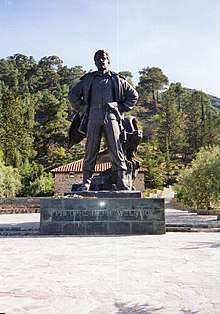Grigoris Afxentiou
Grigoris Pieris Afxentiou (Greek: Γρηγόρης Πιερής Αυξεντίου; 22 February 1928 – 3 March 1957) was a Greek Cypriot guerrilla fighter who fought against the British rule of Cyprus and is considered a national hero. In the hierarchy of EOKA, he was second in command to general Georgios Grivas. His nom-de-guerre was Zidhros (Ζήδρος, the name of a famous 18th-century brigand[2]).
Grigoris Afxentiou | |
|---|---|
 Statue of Afxentiou, 2006 | |
| Nickname(s) | Zidhros |
| Born | 22 February 1928 Lysi, Famagusta, Cyprus |
| Died | 3 March 1957 (aged 29) Near Lazanias, Nicosia, Cyprus |
| Allegiance | Cyprus |
| Unit | EOKA |
| Commands held | Famagusta, Kyrenia, Pitsillia[1] |
| Battles/wars | Battle of Spilia |
Biography
Afxentiou was born in the village of Lysi, Famagusta[3] on 22 February 1928, to Pieris and Antonia Afxentiou. He had a younger sister, Chrystala. He attended Lysi Primary School and received his secondary education at the Hellenic Gymnasium in Famagusta. Reports by those who knew him were that he was a keen sportsman and passionate about football. He supported Anorthosis, one of the strongest clubs in Famagusta.[4]
He left for Greece where he was unsuccessful in gaining a place at the Hellenic Military Academy in Athens. In December 1949 he joined the Hellenic Army as a volunteer. From March to October 1950, he attended the Infantry Reserve Officers' Academy on the island of Syros. He then served with the Hellenic Army on the Greek-Bulgarian frontier, as a second lieutenant, before returning to Cyprus and joining the EOKA struggle.[5]
He was discharged from the ranks of the Greek Army on 15 November 1953 and returned to Cyprus, where he helped his father with his business by working as a taxi driver. At that time he also got engaged to be married.
Afxentiou joined the National Organization of Cypriot Fighters (EOKA) where he soon became Second in Command, adjutant to EOKA leader George Grivas.[6] He was originally assigned the regional command of the district of Famagusta which he knew well.[3] It was Grigoris Afxentiou who first thought of obtaining explosives from the sea bed, in shallow waters off the coast of Famagusta, as used by local fishermen to dynamite fish. Explosives were made from the surplus shells dumped in the sea by the British Army at the end of Second World War.[3] Afxentiou was well liked by his peers and it did not take long for General Grivas to promote him to Commander of the Kyrenia district.[7]
In the spring of 1955, he conducted attacks against the British-controlled Cyprus Broadcasting Corporation and the electricity company in Nicosia. Known by the code name Zidhros (Ζήδρος), since the day of his attacks, he was top of the British list of most wanted men.[8] They initially proclaimed a reward of £250 for his arrest, which was soon raised to £1,000,[9] and then £5,000 pounds for blowing up British property.[10]
When the reward was proclaimed, he went into hiding in the Pentadactylos mountain range where he trained EOKA fighters on weapon use and guerrilla warfare. He was very active in the Pentadaktylos range[1] as well as Mount Troodos.[1]
During October, 1955, on the day after Field Marshal Harding's arrival on Cyprus Afxentiou raided Lefkoniko Police Station, in broad daylight, and seized the entire armoury that was stored there. Although the raid was planned well in advance it clearly appeared as a challenge to the Field Marshal's authority who thereafter pursued Afxentiou zealously.[11]
In December, 1955, Afxentiou was relocated on orders of General Grivas to the Troodos mountain range and the General's hideout at Spilia, which led to Afxentiou's involvement in the Battle of Spilia.[12]
On 3 March 1957, after an informant had betrayed his location, the British forces surrounded Afxentiou outside his secret hideout near the Machairas Monastery near Lazanias, Nicosia.[13] At the time, inside the hideout were Afxentiou and four fellow guerrilla fighters. Realising he was outnumbered, Afxentiou ordered his comrades to surrender but stayed behind to fight to the death.[13] The British asked Afxentiou to surrender his arms but he replied "molon labe" ("come and take them"), quoting King Leonidas of Sparta. Unable to drive him out and after sustaining casualties, the British forces resorted to pouring petrol into his hideout and lighting it, burning him alive. In fear of a popular uprising, the British buried his scorched body at the Imprisoned Graves, in the yard of the Central Jail of Lefkosia,[14] where he lies today.
References
- Grivas Memoirs (1964), p. 54
- Πάνος Ζήδρος (d. ca. 1750), see Claude Fauriel, Chants populaires de la Grèce moderne. Chants historiques (1824), "La Noce du Fils de Zidros et La Mort de Zidros", 65ff.
- Grivas Memoirs (1964), p. 30
- Xystouris, George. "Memory of Grigoris Afxentiou". Anorthosis FC Official Website. Archived from the original on 2008-08-08. Retrieved 2008-08-09.
- Papapolyviou, Petros (2006-03-03). "Grigoris Afxentiou". Phileleftheros (in Greek). Retrieved 2007-03-03.
- Grivas Memoirs (1964)
- Grivas Memoirs (1964), p. 34
- "Presidential Commissioner's Office, Heroes from occupied Cyprus (1955 - 1959) / Ayxentiou Grigoris" (in Greek). Archived from the original on September 30, 2007. Retrieved 2009-01-22.
- "Grivas Memoirs (1964), p. 33
- "Cyprus Bishop's Approach To Disavowal Of Terrorists". The Times Digital Archive. July 23, 1956. pp. 7, Issue 53590, col D. Archived from the original on September 6, 2003. Retrieved 2008-05-02.
- Grivas Memoirs (1964), p. 48.
- Grivas Memoirs (1964), p. 54.
- Grivas Memoirs (1964), p. 111
- Grivas Memoirs (1964), p. 71
Sources
- The Memoirs of General Grivas by George Grivas, edited by Charles Foley. Longmans. London. 1964.
- Grigoris Afxentiou, a Cypriot fighter
- Learn About Cyprus article (Greek language article about Grigoris Afxentiou)